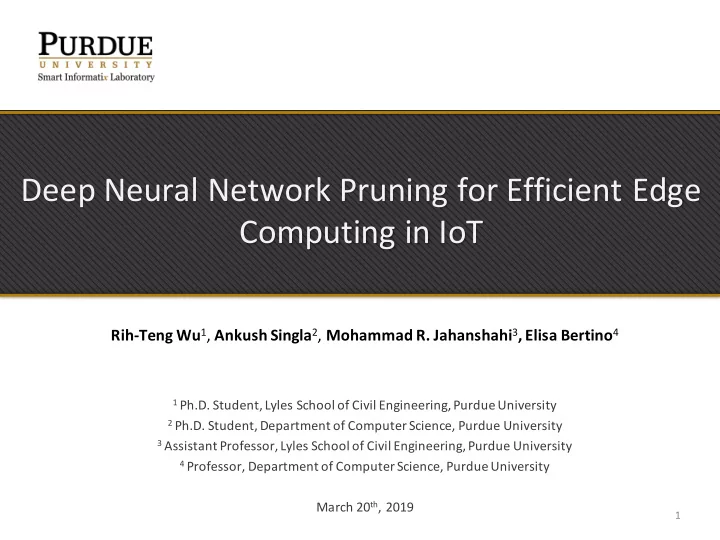

Deep Neural Network Pruning for Efficient Edge Computing in IoT Rih-Teng Wu 1 , Ankush Singla 2 , Mohammad R. Jahanshahi 3 , Elisa Bertino 4 1 Ph.D. Student, Lyles School of Civil Engineering, Purdue University 2 Ph.D. Student, Department of Computer Science, Purdue University 3 Assistant Professor, Lyles School of Civil Engineering, Purdue University 4 Professor, Department of Computer Science, Purdue University March 20 th , 2019 1
Motivation – Internet of Things Source: https://tinyurl.com/yagpsakm 2 Figure adopted from: https://www.axis.com/blog/secure-insights/internet-of-things-reshaping-security/
Motivation – Current Inspection in SHM 3
Motivation – Deep Neural Networks Deep Convolutional Neural Network for SHM Ø Specialized Architecture? Needs a lot of data § Ø Transfer Learning? Not efficient for edge computing 4 §
Network Pruning – Inspiration from Biology 5 Figure adopted from Hong et al. (2013), ” Decreased Functional Brain Connectivity in Adolescents with Internet Addiction.”
Existing Pruning Algorithms Ø Magnitudes of filter weights Ø Magnitudes of activation values Ø Mutual information between activations and predictions Ø Regularization-based approaches Ø Taylor-expansion based approach Molchanovet al. (2017), “Pruning Convolutional Neural Networks for Resource Efficient Inference”, arXiv:1611.06440v2. 6
Network Pruning with Filter Importance Ranking Original Network Evaluate the Importance of Neurons/Filters Find the least important filters based on Taylor-expansion ( Molchanov et al., 2017 ) Remove the Least Important Neurons/Filters Yes Fine-tuning No More Stop Pruning? Pruning
Crack and Corrosion Datasets Crack (training: 25048, testing: 4420 ) Non-crack (training: 25313, testing: 4467 ) Corrosion (training: 28,083, testing: Non-corrosion (training: 29,026, testing: 8 4,956 ) 5,122 )
Computing Units Edge device Server device 9
Result – Transfer Learning without Pruning Ø VGG16 (Simonyan and Zisserman, 2014) *Inference time: the total time required to classify 3,720 image patches of size 224x224. Simonyan and Zisserman (2014), “Very Deep Convolutional Networks for Large-Scale Image Recognition”, arXiv:1409.1556v6. 10
Result – VGG16 with Pruning Crack Corrosion Pruning is conducted on the server device. Ø Accuracy remains descent after pruning followed by fine-tuning. Ø 11
Distribution of Pruned Convolution Kernels Early layers are pruned less, indicating the importance of low-level features. Ø Similar numbers of pruned kernels in layers between the pooling layers are Ø observed. 12
Sensitivity Analysis – Number of Fine-tuning Epochs Crack Corrosion The accuracy is not sensitive to the number of fine-tuning epochs used in Ø each pruning iteration. 13
Sensitivity Analysis – Number of Fine-tuning Epochs Crack Corrosion The accuracy is not sensitive to the number of fine-tuning epochs used in Ø each pruning iteration. 14
Pruning Time Required on the Server Crack Corrosion When using only 1 fine-tuning epoch, the total pruning time is reduced to Ø 1.5(hr), which is approximately 4.6 times faster than using 10 fine-tuning epochs. 15
Result – ResNet18 (He et al., 2015) with Pruning 16
Result – ResNet18 (He et al., 2015) with Pruning Crack Corrosion Pruning is conducted on the server device. Ø Accuracy remains descent after pruning followed by fine-tuning. Ø Pruning is sensitive to the network configurations. Ø 17
Inference Time Required for Pruned VGG16 Crack Corrosion *Inference time: the total time required to classify 3,720 image patches of size 224x224. Server (TITANX): 13.1 (s) is reduced to 4.0 (s) for crack data; 13.2 (s) is Ø reduced to 3.7 (s) for corrosion data. Reduction factor: 3.5 Edge (TX2): 279.7 (s) is reduced to 31.6 (s) for crack data; 275.7 (s) is reduced Ø to 30.6 (s) for corrosion data. Reduction factor: 9 18
Inference Time on Edge Device: VGG16 VS ResNet18 Crack Corrosion *Inference time: the total time required to classify 3,720 image patches of size 224x224. Inference time Ø Ø VGG16: 279.7 (s) to 31.6 (s); reduction factor: 8.9 Ø ResNet18: 36.8 (s) to 8.9 (s); reduction factor: 4.1 Memory: Ø Ø VGG16: 525 (MB) to 125 (MB), 80% reduction 19 Ø ResNet18: 44 (MB) to 2 (MB), 95% reduction
Five-fold Cross Validation Test on VGG16 Crack Corrosion Ø Mean accuracy of 5-fold cross validation test is conducted on server. Ø Network fine-tuning is necessary to enhance the accuracy. 20
Five-fold Cross Validation Test on VGG16 (Cont.) Crack Corrosion Ø The variance in the accuracy after fine-tuning is very small. However, when pruning 97% of the filters, the variance increases and the accuracy after fine-tuning drops. Ø The pruning is stopped when the accuracy after fine-tuning drops more than 3%. 21
Five-fold Cross Validation Test on VGG16 (Cont.) Crack Corrosion Ø The variance in the accuracy after fine-tuning is very small. However, when pruning 97% of the filters, the variance increases and the accuracy after fine-tuning drops. Ø The pruning is stopped when the accuracy after fine-tuning drops more than 3%. 22
Five-fold Cross Validation Test on VGG16 (Cont.) Crack Corrosion Ø The variance in the accuracy after fine-tuning is very small. However, when pruning 97% of the filters, the variance increases and the accuracy after fine-tuning drops. Ø The pruning is stopped when the accuracy after fine-tuning drops more than 3%. 23
Five-fold Cross Validation Test on VGG16 (Cont.) Crack Corrosion Ø The variance in the accuracy after fine-tuning is very small. However, when pruning 97% of the filters, the variance increases and the accuracy after fine-tuning drops. Ø The pruning is stopped when the accuracy after fine-tuning drops more than 3%. 24
Summary Ø Network pruning combined with transfer learning can achieve efficient inference when there is limited training data and computing power. Ø By network pruning, the inference time on edge device is nine and four times faster than the original VGG16 and ResNet18. The network size is reduced by 80% and 95% for the VGG16 and ResNet18 networks, respectively. Ø Different network configurations exhibit different behaviors with respect to pruning. Ø Sensitive analysis shows that pruning can be achieved by using a smaller number of fine-tuning without losing detection performance. Ø The computation gain on the edge device is more prominent than the gain on the server device. 25
Thank you 26
Recommend
More recommend